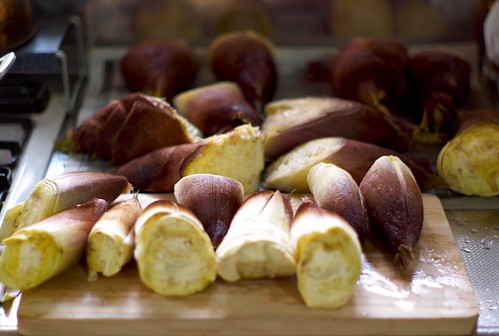
Recently I bumped into a friend who had come from the Clement street shopping district in San Francisco, an area of the city known for Asian markets. He discovered fresh bamboo shoot, and he said it was remarkably good and totally different than the blanched, beige squares most of us think about swimming in our stir fry at the local restaurant. (Thank you, Remy!)
After hunting around a bit, I found some myself and did a bit of research to figure out what I was looking at. It turns out there are hundreds of varieties of bamboo, but only a few are good eating. For a list of the edible varieties, check out Gib, the bamboo maven. When you shop for bamboo shoots in a market, you're most likely to find giant or sweet bamboo, common eating varieties. Bamboo shoots are harvested when they're just a few inches high.
Preparation
If you're lucky enough to find fresh ones, peel, slice thinly or julienne them, and then boil for 30 minutes or more in plenty of water. Cooking not only softens up the woody fibers and leaches out bitter flavors, but it also dissipates a small amount of hydrocyanic acid, which not only tastes bad, but is...well...poison. So, don't forget to boil! They're done when tender and all traces of bitterness are gone.
What's Different
Fresh bamboo shoots have a firmer, snappier texture and fresh vegetal flavor that gets completely lost in canning. You can use them in salads, for garnish on soup, or of course in your favorite asian dishes. Since they can be cut many ways: paper thin slices, square twigs, or rounds, they make for an interesting visual as well as flavor component. I cut mine into thin sheets and rolled them around rice noodles, fresh basil, barbecued tofu pieces, and a smear of hoisin.

